
168 Species in Genus Acer – Maple Tree
How Big Do Bloodgood Japanese Maples Get?
Bloodgood Japanese Maples are known for their striking red foliage and graceful shape. When mature, they typically reach a height of 15 to 20 feet and can spread 12 to 15 feet wide. Their growth rate is moderate, making them a manageable size for many gardens. However, their ultimate size can vary depending on soil conditions, climate, and overall care.
Can Bloodgood Japanese Maple Take Full Sun?
While Bloodgood Japanese Maples can tolerate full sun, they often thrive best with some protection from the intense afternoon heat. In regions with very hot summers, providing them with afternoon shade can help prevent leaf scorch and maintain the vibrant red color of their foliage. In cooler climates, they can handle full sun without any issues.
How Fast Does Bloodgood Japanese Maple Grow?
Bloodgood Japanese Maples are relatively slow-growing. On average, they add about 6 to 12 inches of new growth per year. This slower growth rate means they maintain their refined shape and size, making them ideal for smaller landscapes where a more gradual growth is desirable.
How to Plant a Bloodgood Japanese Maple?
Planting a Bloodgood Japanese Maple requires careful attention to detail to ensure its success. Choose a location with well-drained soil and partial shade, particularly in hotter climates. Dig a hole that is twice as wide as the root ball but no deeper. Place the tree in the hole, ensuring that the top of the root ball is level with the ground surface. Backfill with soil and water thoroughly. Mulch around the base to retain moisture and regulate soil temperature. Avoid placing mulch directly against the trunk to prevent rot.
Are Bloodgood Japanese Maples Deer Resistant?
Yes, Bloodgood Japanese Maples are generally considered deer-resistant. Their foliage is less appealing to deer compared to other plants, making them a good choice for gardens where deer are a concern. However, in times of food scarcity, deer may occasionally browse on these trees.
Can You Keep a Bloodgood Japanese Maple Small?
You can maintain a Bloodgood Japanese Maple at a smaller size through careful pruning. Regular pruning can help control its size and shape while promoting healthy growth. However, avoid heavy pruning, which can stress the tree. It’s best to prune in late winter or early spring before new growth begins.
Does Bloodgood Japanese Maple Lose Leaves?
Bloodgood Japanese Maples are deciduous, meaning they lose their leaves in the fall. This annual leaf drop is a natural part of their growth cycle and contributes to the tree’s seasonal beauty. In the fall, you’ll enjoy a stunning display of vibrant red foliage before the leaves drop.
How Far Away from House to Plant Bloodgood Japanese Maple?
When planting a Bloodgood Japanese Maple near a house, ensure there is adequate space for the tree to grow and develop without causing structural issues. A good rule of thumb is to plant the tree at least 8 to 10 feet away from buildings or structures. This distance allows for proper air circulation and minimizes the risk of root or branch interference with the structure.
How to Propagate Bloodgood Japanese Maples?
Propagation of Bloodgood Japanese Maples is typically done through seed or cuttings. To propagate from seeds, collect and stratify the seeds in a cold, moist environment for a few months before planting. For cuttings, take semi-hardwood cuttings in late summer, dip them in rooting hormone, and place them in a well-draining rooting medium. Keep the cuttings humid and warm until they develop roots.
How to Prune a Bloodgood Japanese Maple?
Pruning a Bloodgood Japanese Maple involves removing dead or diseased branches, as well as any crossing branches that might rub against each other. Prune in late winter or early spring when the tree is still dormant. Make clean cuts just outside the branch collar to encourage proper healing. Avoid heavy pruning, as the tree’s natural shape is part of its charm.
Bloodgood Japanese Maple vs. Emperor
When comparing Bloodgood Japanese Maple to Emperor Japanese Maple, both offer striking red foliage, but there are differences. Bloodgood is known for its vibrant red leaves and a more compact size, while Emperor generally has a larger, more upright growth habit. Bloodgood often has a more intense red color, whereas Emperor may show a broader range of red and purple hues. The choice between them depends on your space and aesthetic preferences.
What to Plant with Bloodgood Japanese Maple?
Bloodgood Japanese Maples pair well with plants that complement their elegant form and colorful foliage. Consider planting them with shade-loving perennials like hostas, astilbes, or ferns. For added texture, you might include ornamental grasses or low-growing ground covers that won’t compete with the maple’s visual prominence.
Is Bloodgood Japanese Maple Toxic?
Bloodgood Japanese Maple is not considered toxic to humans or pets. However, as with all plants, it’s wise to ensure that children and pets don’t ingest large quantities of foliage.
Benefits of Bloodgood Japanese Maple
The Bloodgood Japanese Maple offers numerous benefits, including its stunning seasonal color changes and elegant shape. Its compact size makes it suitable for various garden sizes, and its deer resistance adds to its appeal. This tree provides year-round interest, from its vibrant spring foliage to its striking fall color.
Common Problems
Common issues with Bloodgood Japanese Maples include leaf scorch in hot climates, root rot in poorly-drained soil, and fungal diseases like powdery mildew. Regular watering, proper site selection, and preventive treatments can help manage these problems effectively.
In summary, Bloodgood Japanese Maples are a beautiful and manageable choice for many gardens. With proper care, they can provide years of stunning foliage and graceful form, making them a cherished addition to any landscape.
If i die, water my plants!



